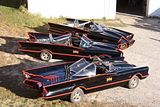Batman first appeared in May of 1939 in Detective Comics #27, and although the first true Batmobile did not appear for another two years, it has become one of the Dark Knight's best known weapons.
The Batmobile made its career debut in Batman #5, then appeared on a comic cover for the first time for Batman #20. Because of different artists' interpretations of what the car should be, it changed size, shape, and features frequently. Later, as the car was marketed beyond the comics, more forms appeared based on practical or aesthetic considerations.
In the 1960s, the first full size, fully operational Batmobile was built for the TV show Batman, and had to face financial and functional questions. A few years later the design of this car would be modified for use in the Superfriends cartoon series, with the unique considerations of making a car that could be easily drawn repeatedly for animation.
Then, nearly three decades after the TV series, Batman returned to live action with Warner Brothers Batman movies. At about the same time, Batman: The Animated series came out, with a whole new take on the design of Batman and his universe. All of this was on top of the natural evolution of the car over 60+ years, taking into account new technological features like the jet engine and the computer. |
|
Batmobile 1966
In the late summer of 1965, an all-new Batman TV series was gearing up, with Dean Jeffries hired to build a Batmobile for the show. When the show's production schedule was moved up, Jeffries had to pass on the job, which then went to custom car builder George Barris. With merely three weeks to build the car, Barris decided to use the Ford Motor Company's abandoned Futura concept car as a basis for what would go on to become one of the most famous cars in the world.
The Futura worked perfectly as a Batmobile, as it had many "bat" features built into the design already, such as the long fins and bubble canopies. According to Barris, he further enhanced the theme by converting the nose into an integrated bat mask, a first for the car. He also opened the wheel wells, and modified the Futura's fins into subtle bat wings by extending their leading edges into the doors and scalloping the trailing edges. Once bodywork was complete, the car was painted gloss black with red trim to accentuate the various lines of he car. Three replicas were eventually built by Barris' shop, though only one appeared on the show itself.
The car featured an impressive array of bat-gadgets. In addition to the "atomic turbine engine" (the car was actually powered by a blueprinted Ford V8), the car had a nose-mounted chain slicer, lasers, rockets, an on-board telephone, radar, dash monitor, on-board computer, and police beacon. If needed, the Batmobile is capable of a quick 180° "bat-turn" thanks to two rear-mounted 10' parachutes, and the it is equipped with a smoke emitter and a nail spreader to discourage pursuit. Some changes were made during the run of the series, including different license plates, a change in steering wheel, and the addition of extra gadgets such as the rear-facing camera and battering ram.
In 1979, the car briefly returned to the screen for the nearly forgotten Legends of the Superheroes show. The Batmobile had gone through several more changes in the years since Batman ended. Most notably, the gloss black paint had been replaced with a flat black flocking, dubbed the "bat fuzz." An array of new and unidentfied gadgets had been added, as well as extra antennas, placards, mirrors, a new seering wheel, and spoked "Euro" wheels. The only subtraction from the car was the bat logos, now absent from both doors.
Today, the #1 car has been returned to its gloss black finish, though many of the extra gadgets remain in place. Along with its enduring popularity, its influence continues in Batmobile designs today and is considered by many to be the Batmobile. |
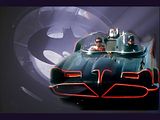
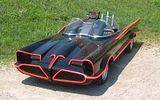
 |
Batmobile 1989
In the summer of 1989, Batman came to the big screen for the first time since 1966. Thanks to the work of comic artists like Frank Miller, the public was ready for a new, darker take on the caped crusader. Warner Brothers had Tim Burton bring his unique style to the movie, and Anton Furst was hired as production designer for Gotham City and the Batmobile. He wanted the car to be unlike any previous incarnation, a combination of brute force and classic design aesthetics. To build the car, the production team spliced together two Impala chassis, and the car was powered by a Chevy V8. The body was a custom-built fabrication, and the whole thing rides on a set of Mickey Thompson racing tires on custom wheels.
In his design, Furst managed to capture the essence of a Batmobile while providing all-new design elements. The bat-mask was gone entirely from his design. In its place, the nose featured a large jet turbine intake flanked by sweeping, mandible-like front fenders. Cold air intakes for the afterburner were mounted ahead of the rear fenders. The rear of the car had a rounded, heavy look that was influenced by cars of the 1930s, set between a pair of relatively short sculpted fins. Inside, the two-seat cockpit featured aircraft-like instrumentation, a passengers' side monitor, self-diagnostics system, CD recorder, and voice-command recognition system.
Gadgets on this Batmobile were relatively simple, but potent. It was armed with spherical bombs, a pair of forward-facing Browning machine guns, side-mounted disc launchers, and chassis-mounted shinbreakers. For quick maneuvers, the Batmobile had side-mounted grappling hook launchers and a central "foot" capable of lifting the car and rotating it 180°. In addition to its armor plated body, the car could envelop itself in a heavy armor cocoon. To avoid capture, the Batmobile also featured three primary pursuit deterrents: oil slick dispensers, smoke emitters, and, in extereme circumstances, a "Batmissile" mode that sheds all material outside of the central fuselage and reconfigures the wheels & axles to fit through narrow openings. Once employed, however, the Batmissle mode essentially destroys much of the car, and it must be rebuilt afterwards.
The car was retired after Batman Returns, though its popularity with fans has established a strong following. It has been used as a basis for several comic book cars, as inspiration for the Batman: The Animated Series car, served as a spokesmodel for OnStar in 1999, and easily ranks with the 1966 car as one of the most popular Batmobiles of all time. |
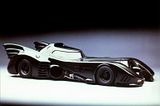
|
Batmobile 1995
The third Warner Brothers Batman movie was released in 1995; Batman Forever. Joel Schumacher was the new director, and created a very different film from his predecessor. One of the changes was a new Batmobile, designed by Barbara Ling. Ling wanted to have a more organic aesthetic, and so designed a car that looked like it actually had ribs and wings. To accentuate the intricate lines of the car, the engine panels, wheels, and undercarriage were indirectly lit so that they appeared to glow blue. The car recalled previous Batmobiles with a split cockpit canopy, seperate fenders, and jet exhaust. The roof fin is also culled from some of the earliest Batmobiles, but it can be opened into a "V" shape for a more contemporary look. In another unique design feature, the wheels were made to keep the bat logos upright when the wheels are turning.
The two-seat cockpit featured a rear-view monitor, system diagnostics display, and custom gauge cluster. If Batman is pursued, the Batmobile had two primary avoidance features. First, it had the ability to lock all four wheels perpendicular to its centerline, to allow for quick sideways movement. Second, for more dire circumstances, the Batmobile could reroute the jet exhaust to under its front end and launch grappling cables at overhead anchors. With the nose up and the lines in place, the car could climb sheer vertical surfaces like building walls as if it were driving on flat ground.
Despite its many defenses, the life of this Batmobile was relatively short. It was destroyed partway through Batman Forever when the Riddler deposited a sack full of explosives in the cockpit. |
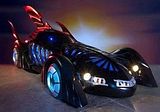
|
Batmobile 2005
After an eight year hiatus, Batman returned to the big screen for Batman Begins. Rather than a sequel or prequel to the previous Warner Brothers movies, Begins was considered a restart, effectively starting the Batman movie universe from scratch. Among the new ideas to appear in this movie was an all-new Batmobile, designed by Crowley & Nolan and built by movie car engineers Chris Corbould and Andy Smith. Their primary focus was to make this Batmobile as real as possible: at 9 feet wide and 15 feet long, the car weighed in at 2.5 tons but was still capable of 0-60MPH in under six seconds with a top speed of 110MPH. Thanks to its unique design, it is also capable of making unassisted jumps up to 30 feet.
After years of training, Bruce Wayne returns to Gotham City ready to start cleaning out the criminal element. Recognizing that he needs materials to carry out his mission, he joined Lucius Fox in Wayne Enterprise's Applied Sciences division. Fox was placed in Applied Sciences as punishment, as the division is seen as a dead-end career track responsible for projects deemed too expensive or problematic for practical application. Bruce, on the other hand, saw the division as an opportunity to put these rejected projects to use as Batman. After reviewing the body armor, high-tension lines, and memory cloth, Bruce saw a set of tires poking out from under a tarp. Fox then introduced him to the "Tumbler," an experimental bridging vehicle that never quite made it. The concept of the vehicle was this: thanks to adjustable control surfaces and a jet engine, the Tumbler was capable of making rampless jumps to lay the basis for temporary bridges. The "bridge" part of the idea never panned out, so the whole project was scrapped and the prototype was mothballed.
Primary power for this Batmobile came from a 500-HP Chevy 350 V8 driving four 44" Super Swamper tires via titanium axles. The cabin seats a driver and one passenger, with a unique arrangement for the driver: for normal driving situations, the driver simply sits in the left seat. In "attack" mode, the driver's seat moves to the center of the car, and the driver is repositioned to lay face-down with his head in the center section between the front wheels. This serves two main purposes: first, it provides more substantial protection with the driver shielded by multiple layers of armor plating. Second, the prone position reduces the risk of injury a driver faces when making extreme driving maneuvers (stunt drivers are at risk of spine compression when doing jumps - laying down virtually eliminates this risk). In addition to performance and protection, this Batmobile was also capable of attack, with a pair of machine guns mounted in the nose of the car between the front wheels.
The Batmobile easily survived its first adventure, even proving instrumental in stopping Ra's from destroying Gotham City. Time will tell if this Batmobile will appear again, or if will be replaced for the next Batman movie. Despite the mixed reactions from fans on the design of the car, no one can deny that its performance has more than made up for any aesthetic drawbacks. Plus, despite the tank-like look of the new Batmobile, it's not entirely without a bat motif: |
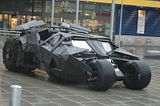
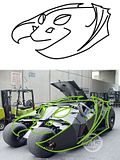
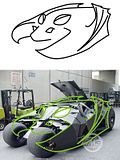
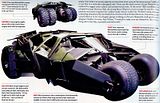
|

